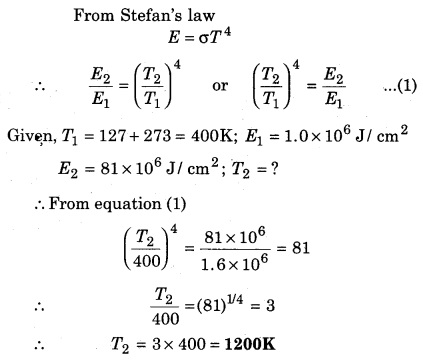Rajasthan Board RBSE Class 11 Physics Chapter 12 Thermal Properties
RBSE Class 11 Physics Chapter 12 Textbook Exercises With Solutions
RBSE Class 11 Physics Chapter 12 Very Short Answer Type Questions
Question 1.
At what temperature does degree centigrade and Fahrenheit scale become equal?
Answer:
\(\frac { C-0 }{ F-32 } \)
Let the temperature is x
∴ \(\frac { x }{ 5 } \) = \(\frac { x-32 }{ 9 } \)
9x = 5x – 5 × 32
x = \(\frac { 5\times 32 }{ 4 } \) = -40°C
Question 2.
What is the unit of specific heat?
Answer:
S.I. unit of specific heat is J/Kg-1 K-1.
In C.G.S system unit is cal/gK.
In MKS system unit is Real/ KgK.
Molar unit of specific heat is cal mol-1 K-1.
Question 3.
At what point, the three states of matter for a substance (solid, liquid or gas) coexist?
Answer:
Triple point.
Question 4.
In which mode of heat transfer, no medium is required?
Answer:
Radiation.
Question 5.
Absorpotion coefficient for an ideal black body is zero. Is this statement true or false?
Answer:
False.
Question 6.
According to Kirchhoffs law, good absorbers are …….
Answer:
Good emitters.
Question 7.
According to Wien’s displacement law, what is the product of wavelength for maximum emission and absolute temperature?
Answer:
λm T = b = 2.9 × 10-3 mK.
Question 8.
Write the relation between °F and K.
Answer:
\(\frac { F-32 }{ 9 } \) = \(\frac { k-273.15 }{ 5 } \)
RBSE Class 11 Physics Chapter 12 Short Answer Type Questions
Question 1.
Why is mercury used in the thermo¬meter?
Ans.
Mercury is used in thermometer for the following reasons :
- It does not stick to the walls of the tube.
- It has high coefficient of expansion, hence the slightest change in temperature is notable.
- It has a shiny surface, so it is easily visible.
- It has high boiling point which makes it suitable to measure high temperature.
Question 2.
Explain the change of state of ice through heat.
Answer:
To understand this take some ice cubes in a beaker and note the temperature of ice. Slowly heat it. It is observed that there is no change in temperature as long as there is ice in the beaker.
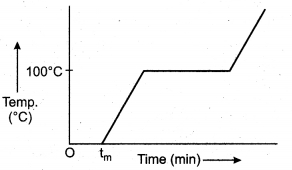
In this process, even though the heat is continously supplied, but the temperature does not change. The heat supplied is used in changing the state from solid to liquid (ice → water).
The temperature remains 0°C until the ice melts. At this point, further heat transfer will produce a temperature increase of liquid phase till it reaches 100°C, the boiling point of water. It remains at 100°C till all the water change into gass (steam).
Question 3.
Explain the conduction mode of heat transfer.
Answer:
- In conduction, the heat transfer takes place at the molecular level without actual movement of molecules, from the hottest to the coldest surface.
- In the process of heat transfer, the molecules pump into their neighbors and transfer the energy to them which continues as long as heat is still being added.
- The transfer between bodies continues until the temperature difference decays and a state known as thermal equilibrium occurs.
- Greater the value of thermal conductivity K of a body better is its heat conducting capability.
- For insulator this value of K is zero.
Question 4.
Why is displacement term used in Wien’s displacement law?
Answer:
According to Wien’s displacement law λm T = b = 2.90 × 10-3 mK.
That is on increasing the temperature λm moves towards the lower part of spectrum and when the temperature decreases, λm gets displaced towards the higher end of the spectrum. This is why it is called Wien’s displacement law.
Question 5.
Give a brief note on black body.
Answer:
The energy radiated by a hot body depends on the nature of the radiating surface. A black body absorbs all the radiations falling on it and emits radiation that are independent of the shape, size, material and nature of the surface selected for the body and depends on its temperature.
A black body is an ideal abstraction and cannot be realised in practice. For rough work, we use surface coated with lamp-black or platinum black; but for more accurate work, black body designed by Fery is used.
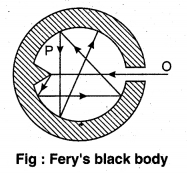
Fery constructed an enclosure having a hole. The hole O should be placed against the conical projection P of the enclosure and the enclosure should be coated black from inside. Any radiation falling on the hole passes through it and is completely absorbed due to successive reflections.
When we heat the enclosure, the black-body radiations come out from the hole and not the enclosure, that acts as a black body. A black-body is most convenient reference for the study of radiation emitted by hot bodies.
Question 6.
Differentiate between emissive and absorption power.
Answer:
Absorption Power:
- It is the ability of a body to absorb radiant energy.
- Total absorptive power of a body is the ratio of energy absorbed to energy falling.
- Spectral absorptive power for perfectly black body is 1.
Emissive Power:
- It is the ability of a body to emit radiation.
- Total emissive power of a radiating body is the total amount of energy radiated per second per unit area of the surface.
- The total emissive power of a black body (at same temperature) has the maximum value.
Question 7.
What do you understand by Triple point?
Answer:
Triple Point : Triple point of a pure substance is a very stable state signified by constant pressure and temperature. Due to this, triple point of water in Kelvin’s temperature scale, is taken as the upper fixed point.
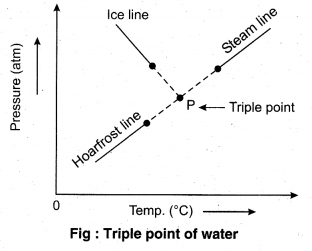
When we increase the pressure, melting point of a solid decreases and boiling point of the liquid increases. We may get the co-existence of the three states of matter simultaneously by adjusting pressure and temperature. These values of pressure and temperature signify Triple point.
Question 8.
Differentiate between heat and temperature.
Answer:
Heat:
- Form of energy transferred between two or more systems and its surroundings due to difference in temperature.
- Its unit is calorie (cal) and S.I. unit is joule (J).
- Due to difference in temperature of two bodies the heat transfer takes place between them.
Temperature
- It is a measure of hotness or coldness of a body.
- Its S.I. unit is kelvin.
- Temperature difference decides the direction of heat energy flow between two bodies.
RBSE Class 11 Physics Chapter 12 Long Answer Type Questions
Question 1.
Explain the three modes of heat transfer.
Answer:
The tightly screwed lids or sealed bottles are first put in hot water so that the lid expands. In case of liquids, when the thermometer is put in a slightly warm water, the mercury in it rises. When the thermometer is taken out, mercury falls again.
In case of gases, a balloon partially inflated in a room (cool) expands when put in warm water. Also, a fully inflated balloon when placed in cold water starts shrinking.
Most of the substances expand on heating while contract on cooling. Change in the temperature of a body causes change in the dimensions of the body. The increase in dimensions of a body because of increase in its temperature is known as thermal expansion. The change in length is called linear expansion. The increase in area is called area expansion. The expansion in volume is called volume expansion.
When the substance is in the form of a long rod, then for small change in temperature (∆T), the fractional change in length (∆l/l0) is directly proportional to ∆T.
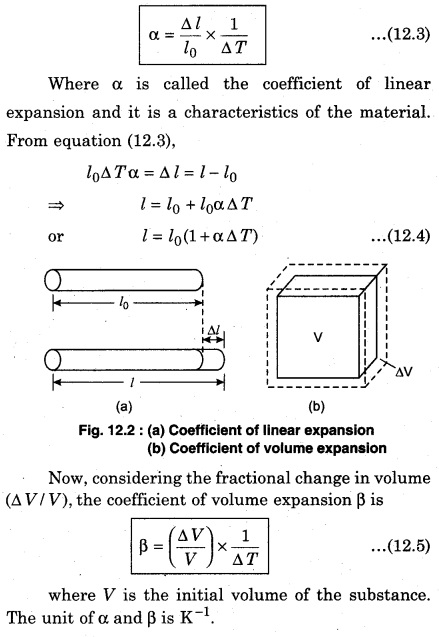
β is also a characteristic of the substance. Generally, it depends on the temperature. It becomes constant only at a high temperature. The value of β is more for those metals whose melting point is low. The value of β is least for solid, more than solids in liquids, maximum in gases.
From ideal gas equation, we know that
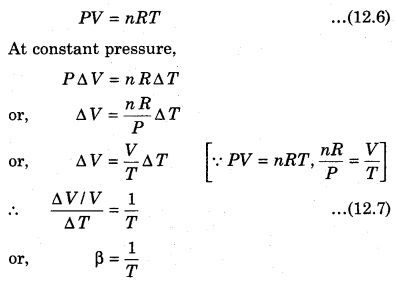
Now, we will establish the relation between α and β.
Consider a rectangular cuboid of length l1, l2 and l3 and on increasing the temperature by ∆T, the length changes to l‘1,l‘2 and l‘3 respectively. Then, according to equation (12.4),
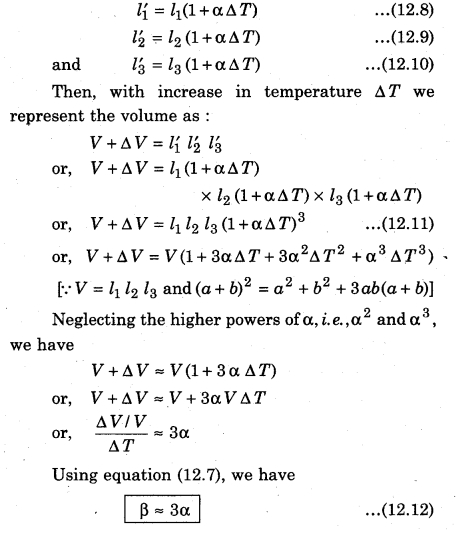
This means that the coefficient of volume expansion is thrice the coefficient of linear expansion.
Water shows an anomalous behaviour. When it is heated between 0°C and 4°C, it contracts. The volume of given water reduces when it is cooled from the room temperature till it reaches 4°C. The density decreases as the volume increases below 4°C.
So, water has maximum density at 4°C. This property of water has an important effect on the environment. Lakes and ponds freeze at the top first. A lake starts cooling around 4°C, water near to the surface losses energy and becomes denser and sinks. The warmer water near the bottom rises. When the colder water on the top reaches below 4°C, then it becomes less dense. This way, animal and plant life is saved in cold region.
Question 2.
State and prove the Kirchhoffs laws. Why a red glass appears green?
Answer:
Temperature is a physical quantity that measures hotness or coldness of the body. The body that feels hot has a higher temperature than the body that feels cold. The device used to measure temperature is called thermometer.
We have experienced that a glass of ice cold water placed on a table (at room temperature) on a hot summer day eventually becomes warm; but a cup of hot coffee placed on the table cools down. So, an exchange of energy has taken between-water or coffee and the surrounding. This transfer of energy takes place till thermal equilibrium is reached.
So, temperature is that physical quantity of an object which tells whether an object is in thermal equilibrium with the other object or not. If the two objects kept in contact are not in thermal equilibrium, then heat will flow from object at high temperature to the object at lower temperature. When the temperature of both the objects becomes equal the heat flow stops. So, temperature is that physical quantity of an object which decides the direction pf flow of heat.
The S.I. unit of temperature is Kelvin and its value is \(\frac { 1 }{ 273.16 } \) point of water. Temperature is a scalar 273.16 quantity.
Other than kelvin scale, temperature can be measured in degree Celsius, fahrenheit, etc.
Heat : Heat is a form of energy. The hotness or coldness of any object is felt by it. When a hot object and a cold object are brought in contact with each other then the energy flows from hot to cold object. The energy transferred in this process is heat. The unit of heat is joule (J) or calorie. One calorie is defined as the quantity of heat energy required to raise the temperature of one gram (lg) of water from 14.5°C to 15!5°C.
- 1 Kcal = 103 Calorie
- 1 calorie = 4.186 Joule.
Question 3.
State and prove Newton’s law of cooling.
Answer:
A hot body left to itself slowly cools down to the surrounding’s temperature. It was Newton who found that the rate of cooling depends on the temperature difference between the hot body and the surrounding. Newton’s law of cooling states that, the rate of energy loss by a hot body is directly proportional to the temperature difference of hot body and surrounding (if the temperature difference is small), i.e.,

where ∆Q is the amount of heat lost in ∆t seconds by a hot body. Consider a hot body at temperature T. Let T0 be the temperature of its surroundings. According to Newton’s law of cooling.
Rate of loss of heat ∝ Temperature difference between the body and its surroundings

Where k is a proportionality constant depending upon the area and nature of the surface of the body. Let m be the mass and s the specific heat of the body at temperature T. If the temperature of the body falls by small amount dT in time dt, then the amount of heat lost is
dQ = msdT …(12.21)
∴ Rate of loss of heat is given by
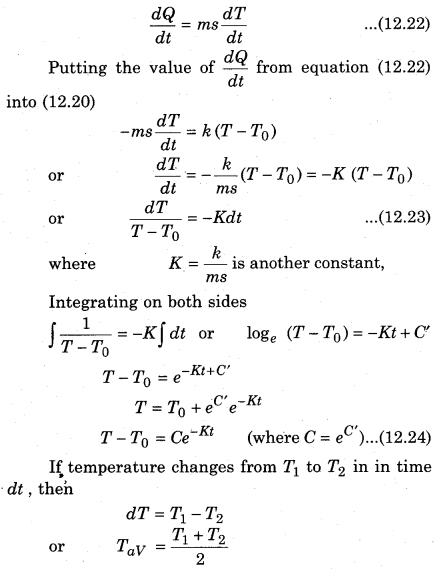
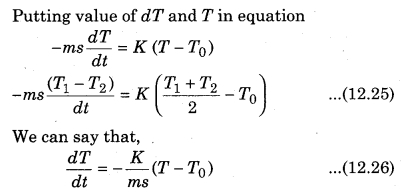
Using equation (12.26) we can calculate the time of cooling of a body through a particular range of temperature.
If we plot a graph by taking different values of temperature difference ∆T = T – T0 along y-axis and the corresponding values of t along x-axis, we get a curve of the form shown in figure 12.13 (a). It clearly shows that the rate of cooling is higher initially and then decreases as the temperature of the body falls.
Morever the equation is of the form y = mx + c. So, if we plot a graph by taking log (T – T0) along y-axis and time t along x-axis, we must get a straight line, as shown in figure 12.13 (b). It has a negative slope equal to -K and intercept on y-axis equal to c.
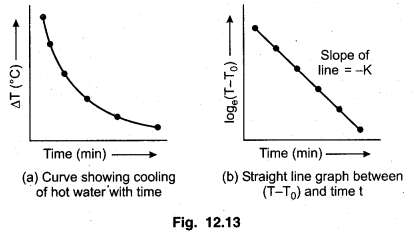
Experimental Verification of Newton’s Law of Cooling: The experimental set-up used for verifying Newton’s law of cooling is shown in figure
12.14. The set-up consists of a double walled vessel (V) containing water in between the two walls. A copper calorimeter (C) containing hot water is placed inside the double walled vessel. Two thermometers through the corks are used to note the temperatures T of hot water in calorimeter and T0 of water in between the double walls respectively.
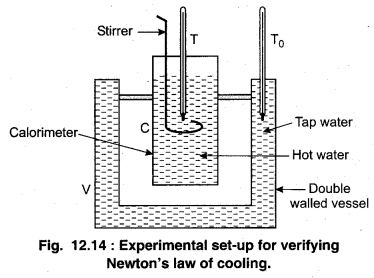
Temperature of hot water in the calorimeter is noted after fixed intervals of time, say after everyone minute of stirring the water gently with a stirrer. Continue noting its temperature about 5°C above that of surroundings. Plot a graph between loge(T – T0) and – time (t) shown in a figure 12.13.
The nature of the graph is observed to be a straight line, having a negative slope. This verifies Newton’s law of cooling.
Question 4.
State Stefan’s law and obtain Newton’s law of cooling from Stefan’s law.
Answer:
In 1879, Stefan, on the basis of his experiments, observed that the total energy radiated spread over the whole range of wavelengths from zero to infinity per second per unit area of a black body is the area under the particular curve (Eb). Eb depends upon T4, where T is the temperature of hot body.
Area under Ebλ – λ curve,

Stefan-Boltzman law states that the total energy emitted by a black body per second per unit area is directly proportional to T4 (the fourth power of absolute temperature).
![]()
When a black body at T1 temperature is surrounded by another such body at T2 temperature, it emits energy at the rate of σ T14 and gains energy at the rate of σ T24 per unit area from the surrounding body.
So, the energy radiated in time A t s from an area A,

When the body is not perfectly black, radiations are neither emitted nor absorbed.
The ratio of energy radiated by a real body is a real function (ε) of the energy radiated by a black body at the same time.
Let the fraction absorbed by the real body he a, then α = ε.
Consider a non-black body at T1 temperature surrounded by a black body at T2 temperature, then,
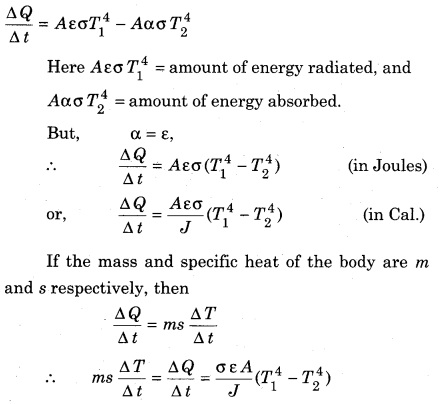

Let the area of cross section of a body be A at temperature T1 and the temperature of the surrounding be T2. Then, from Stefan’s law,
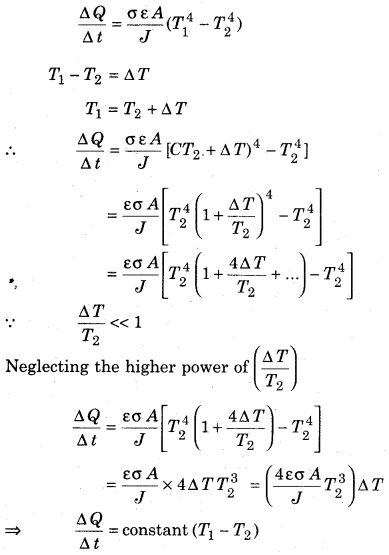
This is the required result for Newton’s law of cooling.
Question 5.
Explain the change of state of substances.
Answer:
Normally, matter exists in three states: solid, liquid and gas. A change from one of these states to another can be done. These changes take place when there is exchange of heat between the substance and its surroundings.
Take some ice-cubes in a beaker. Note the temperature of ice. Slowly heat it. Observe the temperature after every minute and stir the mixture of water and ice continuously. We will see that there is no change in temperature as long as there is ice in the beaker.
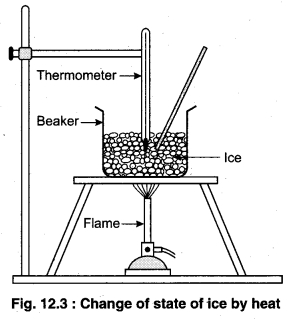
In this process, even though the heat is continuously supplied, but the temperature does not change. The heat supplied is used in changing the state from solid to liquid (ice → water).
The change of state from solid to liquid is called melting and that from liquid to solid is called fusion.
The temperature remains 0°C until all the ice melts. At this point, further heat transfer will produce a temperature increase of liquid phase till it reaches 100°C, the boiling point of water. It remains at 100°C till all the water changes into gas (steam).
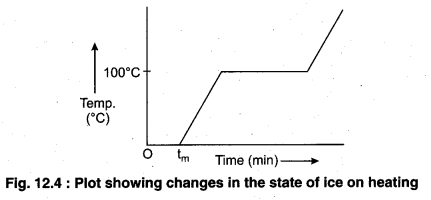
Melting Point: The temperature at which the solid and liquid state of substance (in thermal equilibrium) coexist with each other is called its melting point. The melting point of a substance depends on the nature of the substance. It also depends upon the pressure.
Boiling Point: The temperature at which the liquid and the vapour states of the substance coexist.
Sublimation: It is the change from solid to vapour state without passing through the liquid state. The substances showing sublimation are called sublime. For e.g., Dry ice (solid CO2) and iodine. In this process, both solid state and gaseous state co-exist.
RBSE Class 11 Physics Chapter 12 Numerical Problems
Question 1.
Luminosity of Rigel star in Orion, constellation is 17000 times that of our Sun. If the surface temperature of the Sun is 6000 K, calculate the temperature of the star.
Solution:
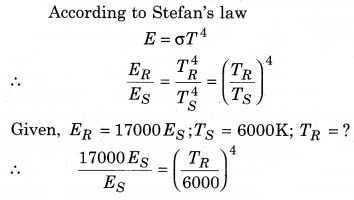
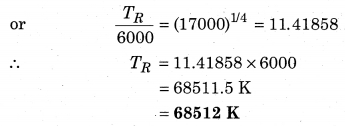
Question 2.
A blacksmith fixes iron ring on the rim of the wooden wheel of a bullock cart. The diameters of the rim and the iron ring are 5.443 m and 5.434 m respectively at 37°C. To what temperature should the ring be heated so as to fit the rim of the wheel. (Given a for iron = 1.20 × 10-5 K-1)
Solution:
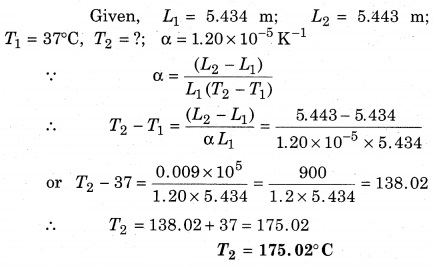
Question 3.
Certain amount of heat is given to 100g of copper to increase its temperature by 21°C. If the same amount of heat is given to 50 g of water, then what is the rise in its temperature? (specific heat capacity of copper = 400J/kgK and that for water = 4200 J / kgK).
Solution:
The amount of heat supplied is given by
Q = mc∆T
Here, m = 100 g = 0.1 kg; c = 400 J/ kg-K
∆T = 21K for copper
Thus, Q = 0.1 × 400 × 21 = 840J
Hence, 840 = 0.05 × 4200 × ∆T
∆T = 4°C
Question 4.
One end of a 0.35 m long metal bar is in steam and the other is in contact with ice. If 10 g of ice melts per minute, what is the thermal conductivity of the metal? Given cross-section of the bar = 7 × 10-4 m2 and latent heat of ice is 3.4 × 105 J/kg.
Solution:
Given, l = 0.35m;
A = 7 × 10-4 m2,
m = 10 g = 10 × 10-3 kg = 10-2 kg;
L = 3.4 × 105 J/kg;
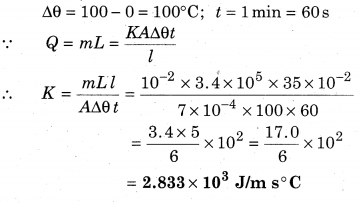
Question 5.
The temperature of the water in a bowl drops to 80°C from 90°C in 5 minutes while room temperature is 20°C. Then find out the time in which temperature falls down to 55°C from 63°C.
Solution:
Given, t1 = 5 min; T1 = 90° C; T2 = 80°C; T0 = 20°C, t2 = ?; T3 = 63°C; T4 = 55°C
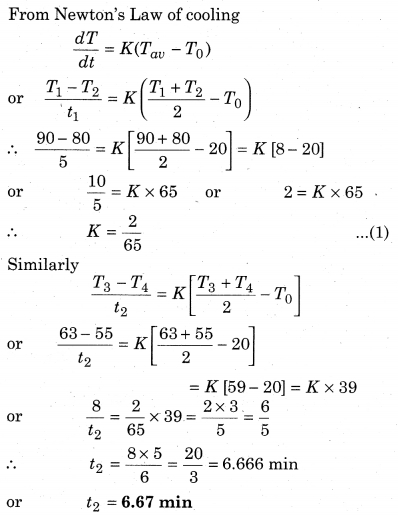
Question 6.
If Sun is emitting energy 1.5 × 103 cal / s from each of its cm2 surface. If Stefan’s constant is 5.7 × 10-8 J/s1 m2 K4 then estimate the surface temperature of the Sun.
Solution:
Given; E = 1.5 × 103 cal s-1 cm-2
= 1.5 × 103 × 4.2 × 104 J.s-1 m-2
= 6.30 × 107 J.s-1 m-2
σ = 5.7 × 10-8 J.s-1.m-2.K-4
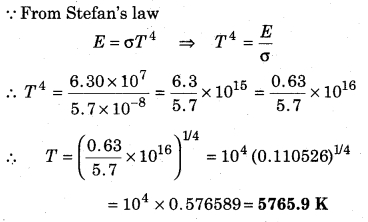
Question 7.
A black body at temperature 127°C is emitting energy at the rate of 1.6 × 106 J/cm2. Find out the temperature of the black body at which emission rate is 81 × 106 J/cm2.
Solution:
